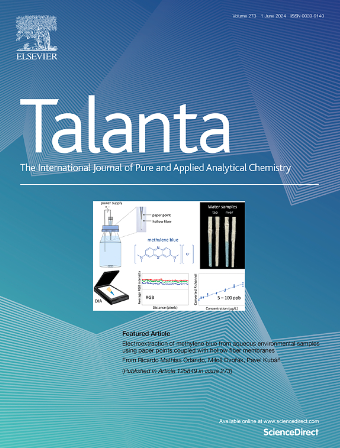Research on a single molecule signal amplification strategy for high risk HPV mRNA based on fluorescent microarray platform
IF 5.6
1区 化学
Q1 CHEMISTRY, ANALYTICAL
引用次数: 0
Abstract
This study introduces a high-sensitivity single-molecule signal amplification approach for detecting high-risk HPV mRNA, utilizing a fluorescent microarray platform (FMP) based on modified entropy-driven chain substitution (EDC). Tailored for the high-throughput detection of 13 high-risk HPV types, the FMP enables concurrent identification of both single and multiple infections, including critical targets HPV16 and HPV18. Clinical validation revealed that the platform achieved over 90 % sensitivity and specificity, with detection sensitivity for HPV16 and HPV18 E6/E7 mRNA surpassing 95 % and specificity nearing 100 %. In samples with multiple HPV infections, the FMP accurately distinguished coexisting types without cross-reactivity, demonstrating its robustness for complex infection profiles. This fluorescence-based platform presents a scalable, precise solution for large-scale HPV screening and diagnostics, especially in resource-constrained environments.
基于荧光微阵列平台的高危HPV mRNA单分子信号扩增策略研究
本研究介绍了一种基于改进熵驱动链取代(EDC)的荧光微阵列平台(FMP),用于检测高危HPV mRNA的高灵敏度单分子信号扩增方法。FMP专为13种高危HPV类型的高通量检测而定制,可同时识别单一和多种感染,包括关键靶点HPV16和HPV18。临床验证表明,该平台的灵敏度和特异性均达到90%以上,其中HPV16和HPV18 E6/E7 mRNA的检测灵敏度超过95%,特异性接近100%。在多种HPV感染的样本中,FMP准确地区分了共存的类型,没有交叉反应,证明了其对复杂感染谱的稳健性。这种基于荧光的平台为大规模HPV筛查和诊断提供了可扩展的精确解决方案,特别是在资源有限的环境中。
本文章由计算机程序翻译,如有差异,请以英文原文为准。
求助全文
约1分钟内获得全文
求助全文
来源期刊

Talanta
化学-分析化学
CiteScore
12.30
自引率
4.90%
发文量
861
审稿时长
29 days
期刊介绍:
Talanta provides a forum for the publication of original research papers, short communications, and critical reviews in all branches of pure and applied analytical chemistry. Papers are evaluated based on established guidelines, including the fundamental nature of the study, scientific novelty, substantial improvement or advantage over existing technology or methods, and demonstrated analytical applicability. Original research papers on fundamental studies, and on novel sensor and instrumentation developments, are encouraged. Novel or improved applications in areas such as clinical and biological chemistry, environmental analysis, geochemistry, materials science and engineering, and analytical platforms for omics development are welcome.
Analytical performance of methods should be determined, including interference and matrix effects, and methods should be validated by comparison with a standard method, or analysis of a certified reference material. Simple spiking recoveries may not be sufficient. The developed method should especially comprise information on selectivity, sensitivity, detection limits, accuracy, and reliability. However, applying official validation or robustness studies to a routine method or technique does not necessarily constitute novelty. Proper statistical treatment of the data should be provided. Relevant literature should be cited, including related publications by the authors, and authors should discuss how their proposed methodology compares with previously reported methods.
 求助内容:
求助内容: 应助结果提醒方式:
应助结果提醒方式:


